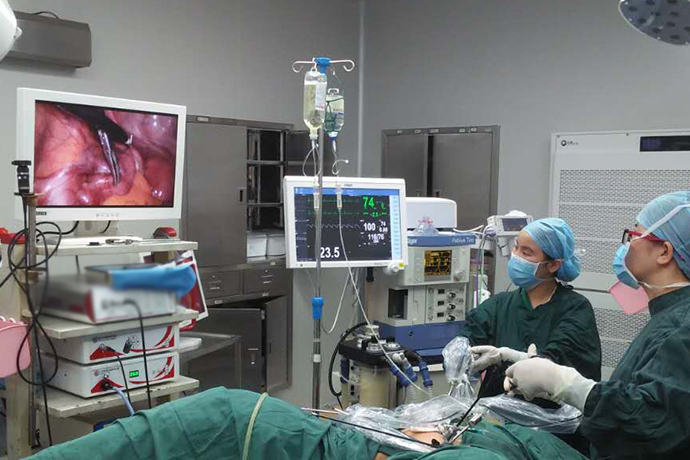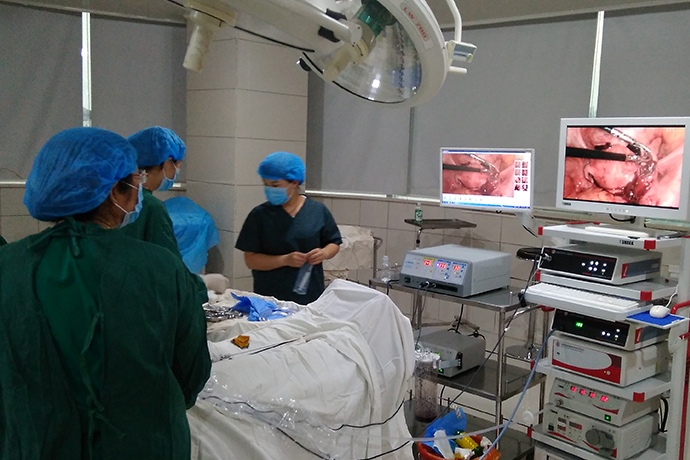[Gynecological Laparoscopy] 4K laparoscopy for incision and drainage of pelvic abscess
Release time: 29 Aug 2023 Author:Shrek
Overview
Pelvic abscesses are one of the common emergencies in women of childbearing age, mainly including pyometra, pyometra, tubo-ovarian abscesses (tubo-ovarian abscesses, TOA) and abscesses caused by acute pelvic connective tissue inflammation. TOA involves the fallopian tube and (or) ovary, which is more serious than pure tubal or pyometra.

Once pelvic abscess develops into septic shock and sepsis, it will seriously threaten the life of the patient, so timely and correct diagnosis and treatment are particularly important.
High risk factors
People with the following risk factors or incentives are more likely to get sick.
1. History of unclean sexual intercourse
2. Placement of the IUD
3. Decreased immunity
4. Long-term drinking and smoking
5. Women of childbearing age: usually around 30 to 50 years old
6. Acute pelvic inflammatory disease not treated in time or repeated attacks
7. History of abdominal surgery
8. Multiple abortions
9. Those who perform artificial assisted conception
10. Diabetes
11. Immune system deficiency
12. Low body mass index
Symptom
Most patients have atypical symptoms, usually manifested as lower abdominal pain, high fever, and a feeling of swelling in the anus.
1. Lower abdominal pain: It often manifests as repeated lower abdominal pain, which is persistent and aggravated paroxysmal, and cannot be relieved by changing positions.
2. Fever: When the infection is severe, it can cause systemic symptoms of fever with (or) chills, and the body temperature is usually high, which can be as high as 39 degrees Celsius or above; the duration of high fever varies according to the condition, and some even last up to 10 days For a long time, in severe cases, the body temperature does not rise but falls.
3. Anal bulging sensation: When pus flows into the deep part of the pelvic cavity, anal bulging and defecation sensations may appear.
4. Irregular vaginal bleeding and pus: purulent discharge is discharged through the vagina, and purulent discharge can be found, which can be mixed with blood. In severe cases, pyuria or pus and blood can be discharged through the urethra or anus.
5. Palpable mass in the abdomen: When the abscess is limited, the mass may be palpable on one or both sides of the lower abdomen, with obvious fluctuating sensation.
6. Shock manifestations: It is the manifestation of abscess breaking through to the abdominal cavity. The condition may suddenly deteriorate or the lower abdominal pain will continue to intensify and turn into full abdominal pain, accompanied by nausea, vomiting, chills, followed by weak and fast pulse, pale complexion, profuse sweating, A sudden drop in blood pressure, etc.
Treatment method
Hospitalization is recommended for pelvic abscesses, with intravenous antibiotics being the preferred treatment option. The principles of antibiotic application are mainly broad-spectrum antibiotics, which cover common pathogenic bacteria in pelvic abscesses.
Surgical treatment: It is mainly used to treat tubo-ovarian abscess or pelvic abscess that is not controlled by antibiotics. Laparoscopic surgery is the first choice.
4K ultra-high definition laparoscopic surgery treatment: compared with laparoscopic surgery and transabdominal surgery, postoperative anal exhaust time, postoperative hemogram recovery time, hospitalization time, postoperative wound infection rate, postoperative intestinal obstruction and postoperative recurrence rate were significantly lower than those in the transabdominal surgery group. The advantages of laparoscopic treatment are as follows. The field of view under laparoscopy is fully exposed, the field of view is clearer, and the color is true. Not only can the pelvic cavity be detected, but the lens can be reversed upward to detect the abdominal hepatic diaphragm, which can clearly define the scope of the lesion and completely remove the abscess. and necrotic tissue; laparoscopic surgery has the advantages of small incision, less operation interference, less intraoperative blood loss, more thorough and effective treatment, and low incidence of incision infection; the impact on the intestinal tract during operation is small, and the incidence of pelvic adhesions after operation is low. Conducive to the preservation of reproductive function.
The case
Color Doppler ultrasound showed that the patient had a hypoechoic mass in the bilateral adnexal area, the size of the right side was about 61×33mm, and the size of the left side was about 69×35mm; blood routine examination showed that the white blood cells were 16.58×10^9/L, and the neutrophil ratio was 76.7% ; Hypersensitive C-reactive protein: 47.50mg/L. The doctor considered it as "bilateral adnexal mass" with infection, and the possibility of pelvic abscess could not be ruled out.
Considering that the patient has a large pelvic mass and bilateral appendages are visible, there are surgical indications and no surgical contraindications
The patient's pelvic cavity was observed during laparoscopy: the pelvic cavity was completely covered with pus moss, and the uterus, bilateral appendages (ovaries and fallopian tubes) were densely adhered to the omentum, rectum, and pelvic wall. Note: During the operation, the adhesions must be loosened one by one carefully, otherwise it may lead to organ perforation.
When the laparoscopic operation reached the stage of bilateral appendage separation, due to the high pressure in the abscess cavity of the two appendages, the pus surged out instantly, and then a large amount of pus flowed out of it, so the doctor immediately performed laparoscopic pelvic abscess removal on the patient And bilateral tubal abscess high-pressure irrigation, considering its fertility requirements, to keep the attachments. The patient lost 20ml of bleeding during the operation, and about 100ml of pus was drained, and he could get out of bed 6 hours after the operation.
Pelvic abscess seriously threatens women's reproductive health, so timely and correct diagnosis and treatment are particularly important. Fortunately, the patient was treated in time and the operation was successful.
Laparoscopic early diagnosis and treatment can not only avoid the blindness of treatment and reduce misdiagnosis, but also can completely eliminate the lesion, separate adhesions under direct vision, incision and drainage of abscess in time, and fully wash and clean the pelvic cavity. Regression, and can improve the patient's reproductive function. Conservative laparoscopic surgery has the least impact on reproductive and endocrine functions, especially for young nulliparous female patients.

- Recommended news
- 【General Surgery Laparoscopy】Cholecystectomy
- Surgery Steps of Hysteroscopy for Intrauterine Adhesion
- [Gynecological Hysteroscopy] Techniques for Preventing and Treating Complications of Hysteroscopic Surgery
- [Gynecological Hysteroscopy] Hysteroscopic Adhesiolysis
- [Gynecological Hysteroscopy] IUD Removal under Hysteroscopy